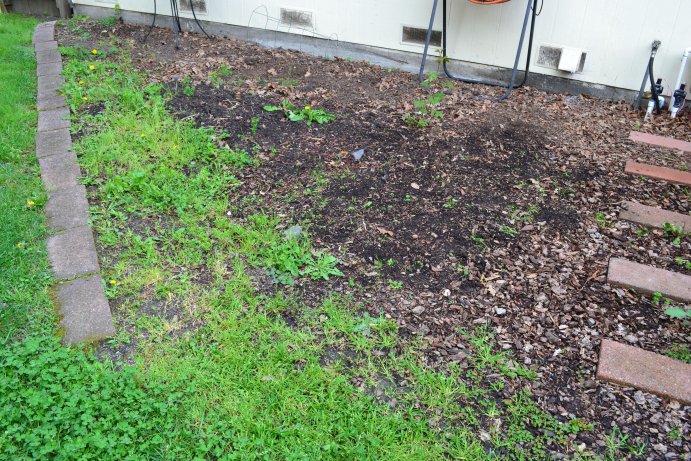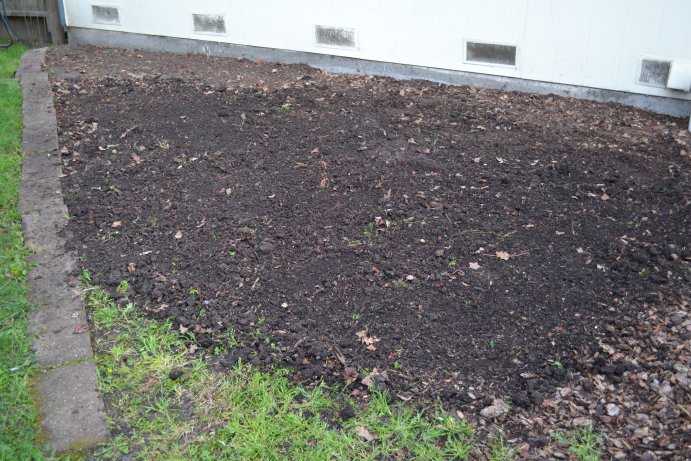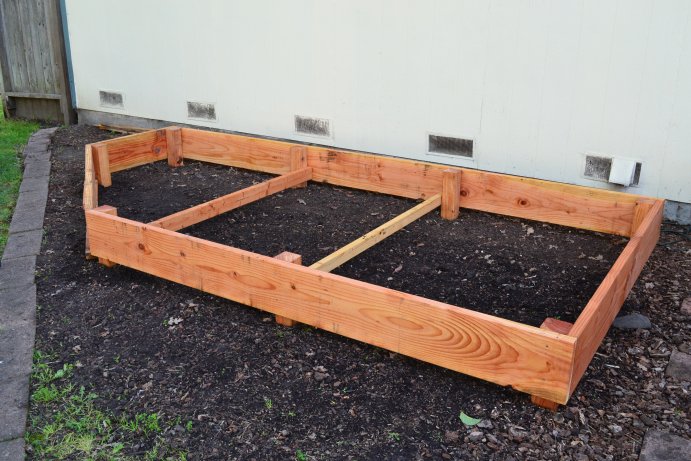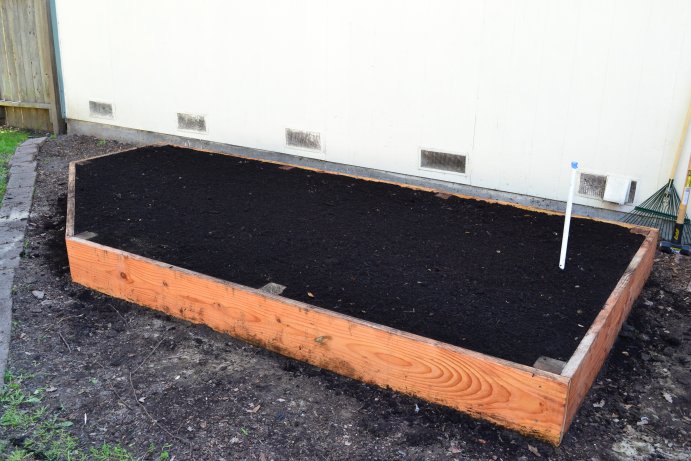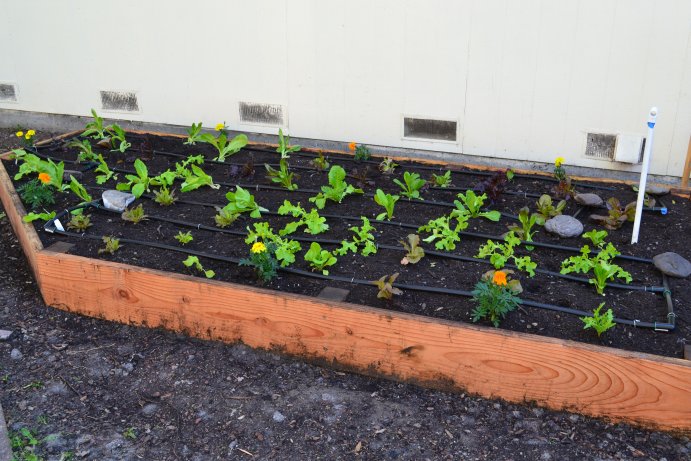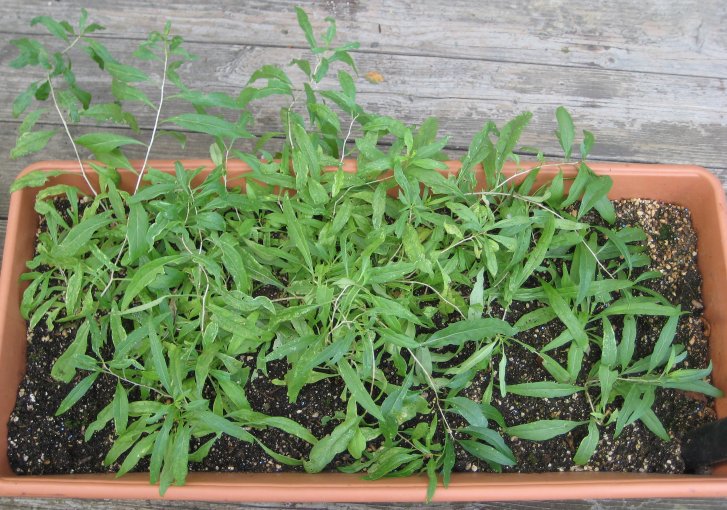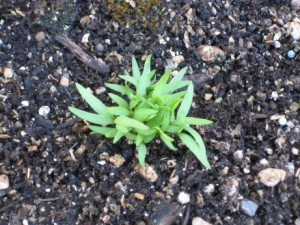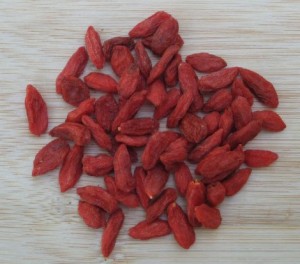Spring is in the air and gardening season has begun in our home! Some of the many joys a raw food enthusiast experiences in Springtime are: preparing soil in raised beds to grow favorite garden vegetables, choosing the perfect vegetable starts, then planting them and watching them grow throughout the season. Harvest time is always exciting, too, as we reap the “fruits of our labor” (and the vegetables, too!).
Plant leafy greens for optimal nutrition
This year, in order to pack our raw vegan diet with optimal nutrition, we’ve planted a plenitude of leafy greens, including several types of lettuce, frisée (curly endive), dandelion greens, arugula, two types of kale, and two types of collard greens. The lettuce varieties we planted are heirloom varieties of green leaf, red leaf, red Romaine, green Romaine, and red oak leaf. Lettuce, frisée, and dandelion greens are all members of the sunflower family (Asteraceae), while arugula, kale, and collard greens are members of the cabbage family (Brassicaceae). Members of this plant family are also known as cruciferous vegetables, and include broccoli, cauliflower, maca, turnip, rutabaga, Brussels sprouts, watercress, red and green cabbage, bok choy, and Napa cabbage.
We’ve also planted several varieties of tomatoes, including some of the heirloom varieties we love, like Pineapple tomatoes, Cherokee Purple, Green Zebra, Brandywine, and several different types of cherry tomatoes. Several tomato varieties love heat, and we planted those in our yard on the south side of the house, which is warmer than the rest of our yard and more sheltered from the wind. Tomatoes are part of the nightshade family (Solanaceae) along with bell peppers, eggplant, potatoes, tomatillos, goji berries, Incan berries, jalapeño peppers, and other hot pepper varieties.
Plant mints in containers for best results
We have quite a few plants from the mint family in our yard this year, including several types of basil and four types of mint. Mints have a tendency to grow and spread prolifically. Early in my gardening career I made the mistake of planting mint in my raised beds and found out the hard way that mint plants have a tendency to “take over” the garden. This year, I learned from past experience and planted the mints in half wine barrels to keep them appropriately contained. However, if you want a very aromatic ground cover, Corsican Mint is a beautiful choice. A couple of years ago, I planted it in a makeshift herb garden in a non-grassy area of my yard. It has since spread and creates a deliciously fragrant chocolate mint addition to the area. It may surprise you to know that Chia seeds are another member of the mint family famously popular in the raw food community!
On the other hand, most types of basil stay localized in their growth habit, so I plant basil directly in my raised beds. They make a lovely companion planting next to the tomatoes, and the two are a perfect culinary combination, especially in Italian cuisine.
Fruit-bearing plants in our yard include two types of lemon trees and a fig tree, which is already producing numerous small figs. The fig tree is only five years old, and has already been producing numerous baskets of figs for the last three seasons. Since we adore figs, we’re really looking forward to harvest time later this year!
Plant fruits and vegetables no matter where you live
This is a small sampling of the foods we are currently growing in our yard and garden. We enjoy being able to create more diversity in our raw food diets and growing foods we enjoy that can be harder to find in the grocery store aisles. Even more importantly, we notice a big difference in the taste and quality of the foods we grow compared to the ones we buy. We suggest growing fruits and vegetables—you’ll be well rewarded in both taste and nutritional value. Before we had a back yard, we grew vegetables and fruits on our apartment patio, and sprouts, greens, and grasses near a window in our dining room. There are so many ways to grow your own food, and at harvest time, you’ll be grateful that you made the worthwhile effort. Happy gardening!
One of the best ways to keep in touch with us is to join our email list. You’ll receive a free copy of Our Top 12 Strategies for Long Term Success on A Raw Plant-Based Diet eBook along with regular information about raw food and plant-based diets and periodic promotions for our classes, events, and other offerings!
Video Series of How We Constructed a Raised Bed Garden: Parts 5 and 6 and Harvest Time!
Here are our most recent videos documenting our raised bed garden project. Since we live in northern California, we have dry summers and need to have an irrigation system to water our plants, which is especially handy when we are out of town teaching. This video shows the installation of the irrigation timer:
We have been harvesting the lettuce from our raised bed for a couple of weeks now – it is incredibly fresh and flavorful and has grown surprisingly quickly. Here is a video progress report:
Our raised bed is almost complete. The remaining aspect of this project is designing and finalizing the area around the bed to blend its appearance with the rest of our backyard. We will post a video when this final aspect of the project is finished. Have a great week!
One of the best ways to keep in touch with us is to join our email list. You’ll receive a free copy of Our Top 12 Strategies for Long Term Success on A Raw Plant-Based Diet eBook along with regular information about raw food and plant-based diets and periodic promotions for our classes, events, and other offerings!
Video Series of How We Constructed a Raised Bed Garden: Parts 3 and 4 and Garden Update
A couple of days ago, I returned from being out of town visiting family on the east coast to see that our lettuce had grown significantly since we planted it three weeks ago:
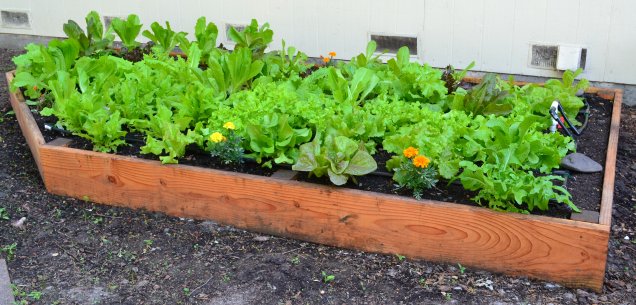
For comparison, here is the size of the lettuce when we planted it:
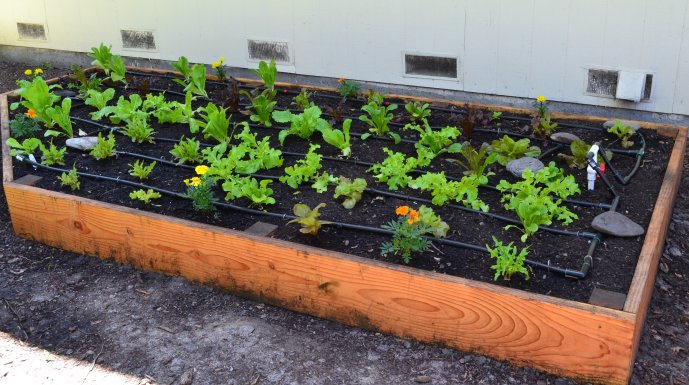
In less than a month, we are already reaping the benefits of our efforts on this several day project! The lettuce is so vibrant and fresh, and without a doubt we feel that the time and energy we put into this project was more than well worth it.
Now, on to the latest videos:
Here is video number 3 showing the planting and irrigation setup for the lettuce bed:
Here is video number 4 showing the ball valve and drip emitter installation:
Next week: Part 5 of this video series, showing the installation of the irrigation timer.
One of the best ways to keep in touch with us is to join our email list. You’ll receive a free copy of Our Top 12 Strategies for Long Term Success on A Raw Plant-Based Diet eBook along with regular information about raw food and plant-based diets and periodic promotions for our classes, events, and other offerings!
Video Series of How We Constructed a Raised Bed Garden: Parts 1 and 2
As we wrote in this blog last week, Rick and I recently converted a weedy unused area of our backyard into a raised bed garden for our lettuce plants.
Part 1 shows the planning of our raised bed:
Part 2 shows the construction of our raised bed:
Next week, we will post parts 3 and 4, showing the installation of the irrigation system and planting of the lettuce.
One of the best ways to keep in touch with us is to join our email list. You’ll receive a free copy of Our Top 12 Strategies for Long Term Success on A Raw Plant-Based Diet eBook along with regular information about raw food and plant-based diets and periodic promotions for our classes, events, and other offerings!
Ready, Set, Grow!
 Rick and I have been growing vegetables in backyard raised beds for the past few years and have learned much from our experience. One thing we have learned and observed first hand is the self-evident notion that some plants thrive in areas of our yard that have more sun, while other plants grow better in shady areas. Case in point: lettuce. The lettuce we have grown tends to wilt in the hot afternoon sun regardless of how much water we give the plants.
Rick and I have been growing vegetables in backyard raised beds for the past few years and have learned much from our experience. One thing we have learned and observed first hand is the self-evident notion that some plants thrive in areas of our yard that have more sun, while other plants grow better in shady areas. Case in point: lettuce. The lettuce we have grown tends to wilt in the hot afternoon sun regardless of how much water we give the plants.
What we historically did for this challenge was to shade the lettuce with large beach and patio umbrellas. Of course, gardening stores do sell shades specific for this purpose, but this year we came up with a more permanent solution, which was to build a raised bed for the lettuce in an area of our yard that gets some sun in the morning, but is shady during the hottest part of the day, the afternoon. This location will be especially important as the growing season progresses and the daily temperature rises.
The area where we built the lettuce bed is adjacent to our house, and in the morning until about midday, the lettuce receives sunlight and then as the sun moves across our yard in the afternoon, our house shades the lettuce. So far so good! The lettuce has been growing beautifully, but the real test will be later in the season as summer approaches.
Here are some photos showing the transformation of an unused weedy area into our lettuce bed!
Here is the area weeded and leveled for construction of the bed:
Here is the bed:
With added soil:
With plants and irrigation tubing:
A couple days later, the irrigation tubing is hooked into the system, drip emitters are installed, and lettuce plants are growing!
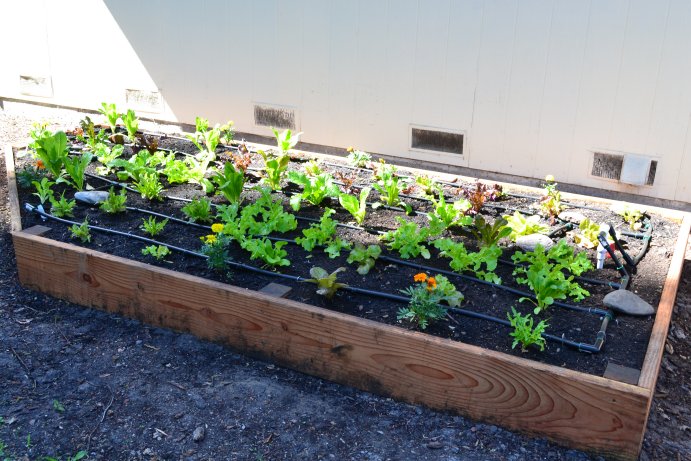
We'll post updates as the season progresses and stay tuned for a series of videos documenting the building of our lettuce bed!
One of the best ways to keep in touch with us is to join our email list. You’ll receive a free copy of Our Top 12 Strategies for Long Term Success on A Raw Plant-Based Diet eBook along with regular information about raw food and plant-based diets and periodic promotions for our classes, events, and other offerings!
Goji Berry Plants – 4 Months Old
Our goji plants have grown quite a bit since we planted the seeds in June – it's time for transplanting 🙂
One of the best ways to keep in touch with us is to join our email list. You’ll receive a free copy of Our Top 12 Strategies for Long Term Success on A Raw Plant-Based Diet eBook along with regular information about raw food and plant-based diets and periodic promotions for our classes, events, and other offerings!
Growing goji berry plants – Update
Rick and I returned home from a long weekend out of town to find that our goji seeds had germinated! We are so excited! Here is a photo of two growing together.
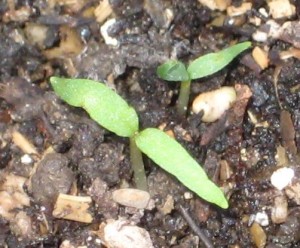
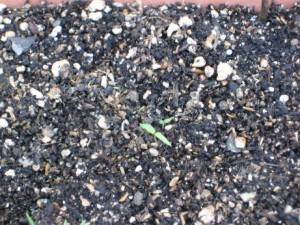
Here is a group of very young goji plants growing together. I planted a whole berry here and it appears that many of the goji seeds germinated.
Our next task is to thin the plants so each can have more space to grow. We’ll keep you updated on their progress. 🙂
One of the best ways to keep in touch with us is to join our email list. You’ll receive a free copy of Our Top 12 Strategies for Long Term Success on A Raw Plant-Based Diet eBook along with regular information about raw food and plant-based diets and periodic promotions for our classes, events, and other offerings!
Growing goji berry plants
At the time, I had never before seen an actual goji plant growing in a garden, given that goji berries are native to Asia and are not popularly cultivated as a garden crop here in the United States. Not surprisingly, the berries on the plant reminded me of tiny Roma tomatoes, given that goji berries (lycium barbarum) are in the nightshade plant family (Solanaceae), the same plant family as tomatoes, potatoes, bell peppers, eggplant, and Incan berries (a.k.a. golden berries).
I was excited to find after doing a little research that goji plants can grow in the area where Rick and I live. I am a big fan of locally grown food, so I thought it would be fun to grow some goji berry plants in my backyard garden.
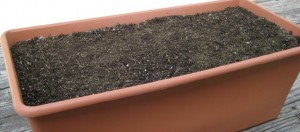
Today, I looked for a suitable container in which to grow my goji seeds. I found an unused planter, filled it with soil, and made ½ inch deep holes about 2 inches apart. I opened several goji berries to find 20+ tiny seeds in each, which I carefully removed and did my best to place one seed in each of the holes. In several of the holes, I placed a single goji berry to see if multiple seeds would germinate together. I filled in the holes with soil and then watered the planted seeds and soil.
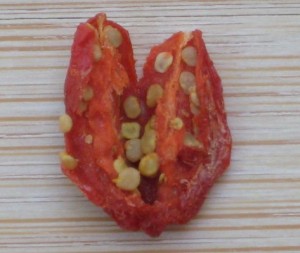
Now that the seeds are planted, I am looking forward to seeing how many, if any, actually germinate and produce plants. I’ll give you updates as the growing season progresses. 🙂



